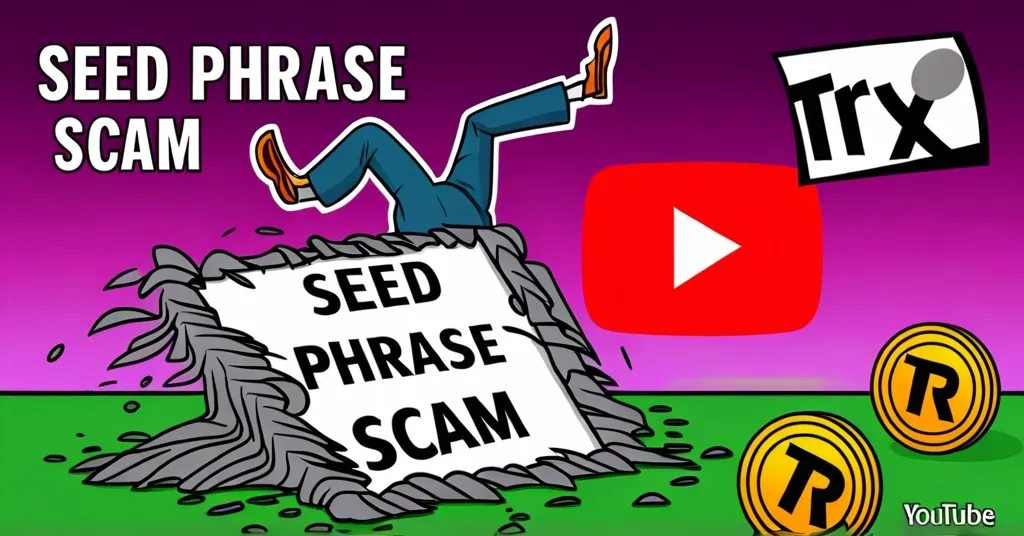YouTube Crypto Scams: Seed Phrases and TRX Fees Trap Unwary Investors

Crypto Scams on YouTube: Fraudsters Exploit Greed and Greed Exploits You
John clicked on a seemingly harmless comment on a YouTube video, and within minutes, he lost his life savings. This is the harsh reality of crypto scams today. Scammers are using YouTube comments to distribute seed phrases, which are lists of words used to recover crypto wallets, like passwords. These phrases are linked to wallets loaded with cryptocurrencies like USDT, promising easy money. But it’s a trap designed to exploit the gullible.
- Scammers use YouTube comments to distribute seed phrases linked to wallets containing cryptocurrencies.
- Victims are tricked into paying TRX gas fees, which diverts their funds to scammers.
- Multi-signature wallets add complexity to the scam, entrapping victims further.
The Bait: YouTube Comments
Scammers post comments on YouTube videos, luring unsuspecting victims with seed phrases linked to wallets on the Tron blockchain, supposedly brimming with USDT. A seed phrase is like a master key to your crypto wallet; if someone else knows it, they can access your funds. These comments prey on the human desire for quick riches, dangling the promise of free money in front of users. The YouTube Seed Phrases Scam has become a popular topic of discussion among crypto enthusiasts.
The Trap: TRX Gas Fees
When victims attempt to access these wallets, they’re hit with a demand for TRX gas fees. Gas fees are transaction fees on the Tron network, necessary to process transactions. Here’s how it works: the victim sends TRX to the wallet to cover the gas fees needed to withdraw the funds. But instead of accessing the promised cryptocurrency, this action diverts their tokens to another wallet controlled by the scammers. It’s like paying a toll to enter a highway only to find out it leads straight to the scammers’ bank account. This TRX Gas Fees Scam is particularly insidious.
The Complexity: Multi-Signature Wallets
Adding to the scam’s intricacy, these wallets often use multi-signature technology. Think of a multi-signature wallet as a safe deposit box that requires multiple keys to open. In legitimate use, this adds a layer of security, requiring multiple private keys to authorize a transaction. But in this scam, it’s another layer of confusion, making it harder for victims to retrieve their funds. They’re already tangled in the scam’s web, and now they need multiple approvals to escape. Understanding multi-signature wallets used in cryptocurrency scams can help in preventing such fraud.
The Impact: Who is Targeted?
Cybersecurity firm Kaspersky has shed light on this operation, noting it’s a targeted strike at those with immoral intentions, rather than typical crypto users. As they put it:
The operation was a sting operation aimed at immoral people and not ‘crypto users.’
This scam isn’t a blanket threat but a calculated move to catch those who might try to exploit others. It’s a sobering reminder of the sophistication of modern crypto scams, blending blockchain mechanics with psychological manipulation. Kaspersky’s analysis provides valuable insights into these tactics.
Protecting Yourself: Safety Tips
So, how do you protect yourself from falling into these digital traps? First and foremost, never use unknown seed phrases or interact with wallets belonging to strangers. It’s like picking up a wallet off the street and expecting to keep the cash inside without any consequences. Always secure your devices, never share your private keys, and be wary of social media ads and cold calls promising free money. For more information on protecting against crypto scams, refer to trusted resources.
Counterpoints and Broader Context
While these scams highlight the dark side of cryptocurrencies, it’s important to remember the potential of blockchain technology to enhance security. Blockchain can offer transparency and traceability that traditional systems lack. Moreover, the crypto community is actively working to combat these scams, with platforms like YouTube implementing stricter policies and regulatory bodies stepping in to protect users. Staying informed about the latest trends in cryptocurrency scams is crucial.
However, the prevalence of such scams raises questions about the education and awareness within the crypto community. Are we doing enough to educate newcomers about the risks? And how can we balance the drive for innovation with the need for security?
Future Outlook
As we push the boundaries of what’s possible with cryptocurrencies and blockchain, staying vigilant is crucial. The promise of freedom and innovation in this space is real, but so are the risks. The crypto community must continue to develop and implement robust security measures, from using two-factor authentication to storing private keys offline. By working together, we can combat scams and build a safer environment for all users. Learning from past incidents, such as crypto scams on YouTube, can help in this effort.
Key Questions and Takeaways
What is the new scam tactic described?
The new scam tactic involves scammers posting YouTube comments with seed phrases linked to wallets holding significant amounts of cryptocurrencies like USDT. Victims attempting to access these wallets are required to pay TRX gas fees, which then diverts their tokens to the scammers.
How does the TRX gas fee trap work?
The TRX gas fee trap requires victims to send TRX to the wallet to cover gas fees for withdrawing funds. However, this action diverts the victims’ tokens to another wallet controlled by the scammers.
What role do multi-signature wallets play in the scam?
Multi-signature wallets add complexity to the scam, requiring multiple approvals for outgoing transactions, which further ensnares victims attempting to withdraw funds.
Who is the primary target of this scam according to Kaspersky?
According to Kaspersky, the primary target of this scam is individuals with immoral intentions, rather than typical crypto users.
What are the recommended safety tips for avoiding such scams?
The recommended safety tips include avoiding the use of unknown seed phrases and not interacting with wallets belonging to strangers. Always secure your devices, never share your private keys, and be wary of social media ads and cold calls promising free money.
As we navigate the world of cryptocurrencies, let’s not forget the importance of staying vigilant. The allure of quick riches is powerful, but it’s also a magnet for scammers. Stay informed, stay skeptical, and remember, if something sounds too good to be true, it probably is. In the pursuit of decentralization and freedom, we must also champion security and responsibility.



